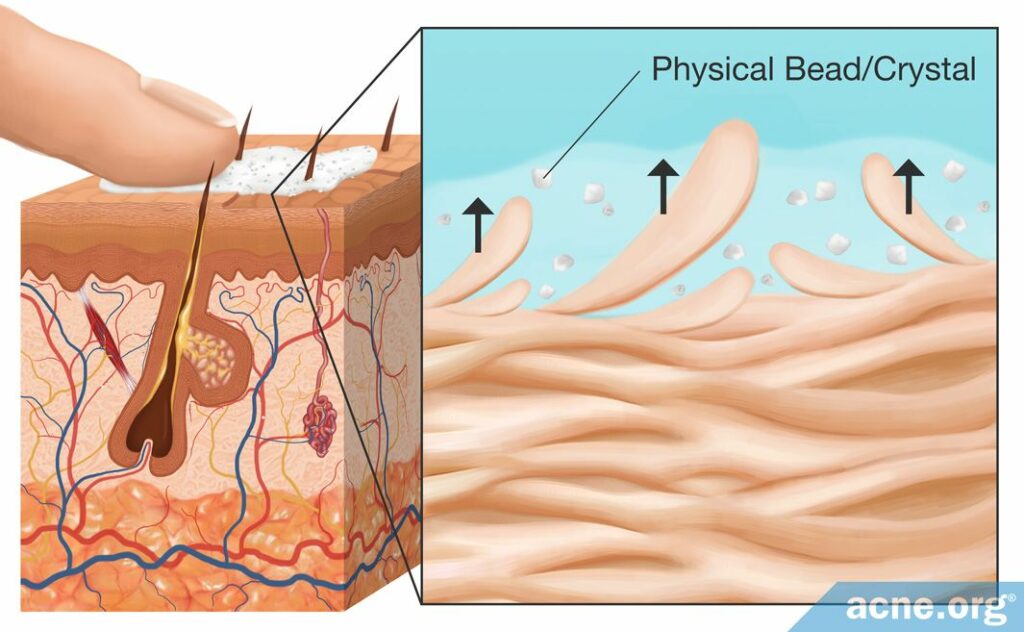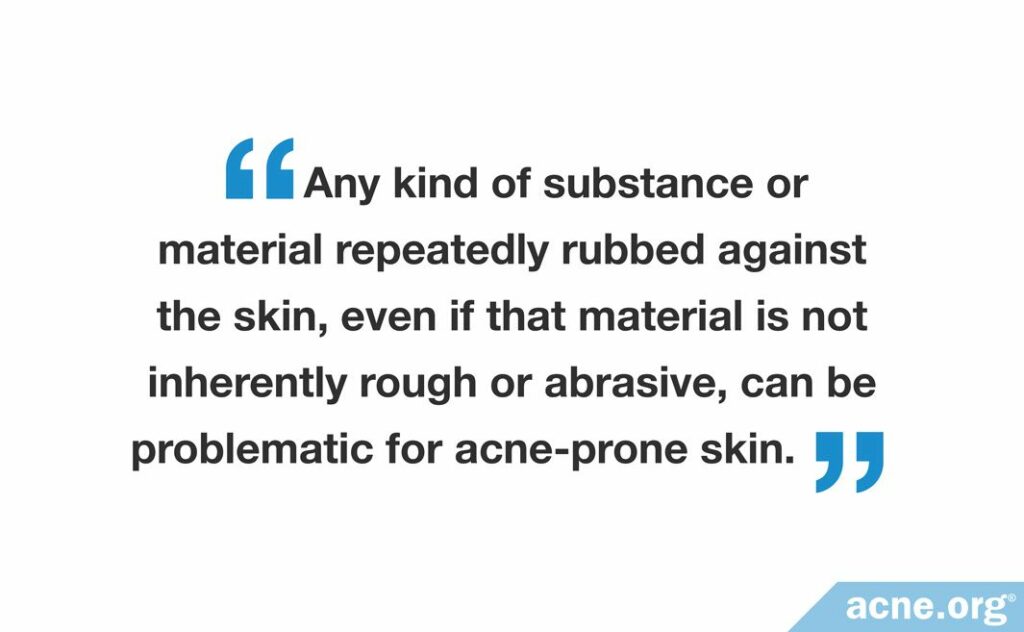Facial Scrubs Do More Harm than Good by Physically Irritating the Skin

The Essential Info
Some manufacturers claim that facial scrubs can improve acne by exfoliating the skin and preventing clogged pores. However, facial scrubs contain particles that when rubbed on the skin can lead to physical irritation, and it is well known that physical irritation can lead to more acne. For this reason, scrubs end up doing more harm than good and should be avoided.
To add insult to injury, the directions on most scrubs call for rubbing the skin “for 1-2 minutes.” This prolonged irritation increases the chance of a breakout.
Instead of using a facial scrub, wash your skin for 10 seconds or less with a gentle liquid facial cleanser using only your bare hands.
If you want to exfoliate your skin, chemical exfoliants like glycolic acid are a far safer option for acne-prone skin.

The Science
- Types of Facial Scrubs
- How Facial Scrubs Work
- Chemical Exfoliation: A Safer Way to Exfoliate
- If You Must Use A Facial Scrub
Facial scrubs contain rough or hard particles that require the user to massage the scrub into the skin, causing the top layer of skin cells to exfoliate. The aim is to give the skin a “fresh glow.” Some facial scrubs also claim that this exfoliation will help with acne keeping pores from becoming clogged.
However, here’s the rub (pun intended): Physically irritating the skin leads to more acne. This is such a well known phenomenon that dermatologists have given it a name: acne mechanica. In short, any benefit from exfoliation is far outweighed by the irritation these scrubs cause.
Types of Facial Scrubs
There are many types of facial scrubs on the market. Scrubs are often named after their main ingredient (i.e. a coffee scrub), which is usually some type of rough or abrasive material such as:
- Crushed nuts
- Crushed shells
- Beads
- Rice or oatmeal bran
- Coffee grounds
- Charcoal particles
- Sugar or salt crystals
How Facial Scrubs Work

The skin is in a continual state of natural exfoliation. Skin cells are born at the bottom of the dermis and slowly move their way to the top of the skin where they die and flake off.
However, sometimes skin cells hang around for too long at the surface of the skin, making the complexion appear dull. This is where facial scrubs come in. These scrubs forcibly exfoliate the top layer of skin cells, giving the skin an artificial “glow.”
What about acne? In acne-prone skin, the natural exfoliation of skin cells is slower than it should be, which can lead to clogged pores. So why not just force faster exfoliation with a facial scrub? As we have discussed, facial scrubs come with one huge negative–they physically irritate the skin and may overdry it. Studies show that any kind of physical irritation can trigger new breakouts or make existing acne worse, so even if the material is not inherently rough or abrasive, rubbing it in can be problematic for acne-prone skin.1-3
Expand to read a case study that shows how using a facial scrub may lead to acne

A 2012 article in the medical journal Dermatology reports on a 17-year-old girl with no previous history of acne who developed severe acne after using a facial scrub daily for several weeks. The authors of the article conjectured that it was the physical rubbing action rather than any specific ingredients in the scrub that had triggered the girl’s acne.4

Of course, most scrubs contain rough particles that increase the chances of skin irritation. A review article published in the Journal of Clinical and Aesthetic Dermatology in 2012 attempted to rank different scrubs by their potential to cause skin irritation.5 The researchers drew attention to the following scrubs:
- Most irritating scrubs: Scrubs containing ground fruit pits or aluminum oxide.
- Least irritating scrubs: Scrubs containing granules of sodium tetraborate dechydrate (borax).5 However, these are rarely found on the market anymore.
Still, even the scrubs in the “least irritating” category have the potential to irritate acne-prone skin because of the rubbing action necessary to apply them.
Chemical Exfoliation: A Safer Way to Exfoliate
Over-the-counter products that contain an alpha hydroxy acid or beta hydroxy acid can achieve the same exfoliation and are safe to use on acne-prone skin. These products exfoliate the skin chemically instead of physically. In other words, they can be gently applied and do the job of exfoliating without the need to physically rub the skin.
This usually means using a product containing glycolic acid, which is the most common acid you’ll find in over-the-counter chemical exfoliants. Glycolic acid products are available in up to 10% strength over-the-counter, which is safe when used in moderation.6 If you do use a 10% glycolic acid product, make sure not to overuse it. Use it at full strength at most once every other day.
If You Must Use A Facial Scrub
If you still want to try facial scrubs, opt for scrubs containing small particles, which are less likely to irritate the skin surface. To find scrubs with smaller particles, look for words like “microparticles” or “microbeads” on the product label.
As you use any facial scrub, pay attention to how your face is looking and feeling. If it becomes red, irritated, or visibly damaged, stop using that product.
However, the safest course of action is to avoid using any kind of facial scrubs.
References
- Tan, S. et al. Acne mechanica. British Medical Journal 1, 130 (1976). https://www.bmj.com/content/bmj/1/6002/130.1.full.pdf
- Seneschal, E. et al. Exogenous inflammatory acne due to combined application of cosmetic and facial rubbing. Dermatology 224, 221-223 (2012). https://www.ncbi.nlm.nih.gov/pubmed/22653048
- Botros, P. A. et al. Evaluation and management of acne. Primary Care 42: 465-471 (2015). https://pubmed.ncbi.nlm.nih.gov/26612368/
- Mills, O. & Kligman, A. Acne mechanica. Archives of Dermatology 111, 481-483 (1975). https://www.ncbi.nlm.nih.gov/pubmed/123732
- Decker, A. & Graber, E. M. Over-the-counter acne treatments: A review. J. Clin. Aesthet. Dermatol. 5, 32‐40 (2012). https://www.ncbi.nlm.nih.gov/pmc/articles/PMC3366450/#B31
- Al-Talib, H. et al. Efficacy and safety of superficial chemical peeling in treatment of active acne vulgaris. Anais Brasileiros de Dermatologia 92, 212-216 (2017). https://pubmed.ncbi.nlm.nih.gov/28538881/
The post Why Facial Scrubs Are Not a Good Choice for Acne-Prone Skin appeared first on Acne.org.
